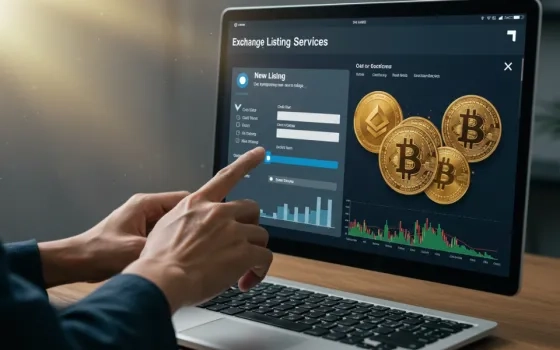In the cryptocurrency industry, few milestones are as celebrated as securing an exchange listing. For blockchain projects, this step is not just about enabling token trading—it is a validation point, a bridge to mainstream adoption, and a trigger for significant changes in market dynamics. Investors and founders alike recognize that once a token transitions from private circulation to being publicly tradable, the entire trajectory of the project shifts. It gains exposure to global liquidity, becomes subject to real-time price discovery, and develops a reputation shaped by both community narratives and institutional judgment.
But what exactly happens when a token gets listed? How do liquidity, price, and market perception shift in response to this pivotal move? And perhaps most importantly, how can projects and investors navigate this transformation strategically? In this blog, we will dive deeply into the mechanics of exchange listings, exploring their influence on liquidity, price behavior, and market sentiment while addressing misconceptions and drawing lessons from real-world examples.
Understanding Exchange Listings in Crypto
Centralized Exchanges vs. Decentralized Exchanges
To fully understand the implications of exchange listings, it’s important to distinguish between centralized exchanges (CEXs) and decentralized exchanges (DEXs). Centralized exchanges like Binance, Coinbase, and Kraken dominate the trading landscape due to their extensive liquidity, advanced trading tools, and compliance frameworks. These exchanges impose strict requirements on projects, from technical audits to regulatory checks, ensuring only select tokens make the cut.
Decentralized exchanges such as Uniswap, SushiSwap, and PancakeSwap provide a more open-access route. Here, tokens can be listed almost immediately once liquidity pools are created, requiring no centralized approval. This makes DEXs crucial for early-stage projects and community-driven ecosystems, but the lack of gatekeeping means they also harbor a higher risk of scams and low-quality tokens.
The Token Listing Process Explained
On centralized platforms, the listing process is far from simple. It often involves months of negotiations, compliance verification, smart contract audits, marketing plans, and sometimes hefty fees. Top exchanges may demand millions of dollars in listing costs, along with liquidity guarantees to ensure smooth trading. For projects, this represents both a financial and strategic commitment.
Why Projects Seek Listings
At its core, the motivation behind pursuing listings is access. A listing allows tokens to reach larger audiences, attract institutional investors, and gain a form of legitimacy in the eyes of the market. More than just a functional step, listings are symbolic—a public declaration that the token is ready for open market participation.
The Role of Exchange Listings in Enhancing Liquidity
Why Liquidity Matters for Tokens
Liquidity is the cornerstone of healthy market activity. In practical terms, it determines how easily tokens can be bought and sold without drastically moving the market price. Illiquid markets deter both retail and institutional investors because large trades create extreme volatility, leading to slippage and losses.
How Listings Expand Liquidity Access
Listings expand the liquidity pool by bringing in new participants. Centralized exchanges provide deep order books supported by market makers, while decentralized exchanges use automated market makers (AMMs) and liquidity pools. In both cases, listings ensure that there are more buyers and sellers, which translates to tighter spreads and smoother trading.
Examples of Liquidity Transformation
When Avalanche (AVAX) secured listings on top-tier exchanges, liquidity surged, making it easier for both retail and institutional traders to participate. This increase in liquidity not only stabilized its price but also created a foundation for DeFi adoption. Conversely, lesser-known tokens that list on obscure exchanges often suffer from thin order books, leaving them vulnerable to volatility and manipulation.
The Liquidity-Trust Connection
Beyond mechanics, liquidity impacts trust. Deep liquidity signals to the market that there is sustained interest in the token. This perception reinforces credibility and attracts even more investors, creating a positive feedback loop. Without sufficient liquidity, even technically strong projects risk being sidelined.
Exchange Listings as a Catalyst for Price Movements
Pre-Listing Hype and Investor Speculation
Exchange listings often act as catalysts for speculative rallies. Announcements alone can spark pre-listing buying frenzies, with traders hoping to capitalize on increased demand post-listing. This speculative phase often pushes prices upward before tokens even go live on exchanges.
The "Pump and Dump" Listing Phenomenon
Yet, the immediate aftermath is often volatile. Many tokens experience dramatic price spikes in the first hours of trading, only to crash as early investors cash out. Dogecoin and Shiba Inu, for example, saw huge post-listing spikes on platforms like Binance but also sharp corrections shortly after as hype-driven traders exited.
Long-Term Price Stability and Market Makers
While short-term movements can be chaotic, long-term stability depends on fundamentals: token utility, liquidity, adoption, and investor confidence. Market makers play a key role here by balancing order books, reducing volatility, and encouraging institutional participation. Without them, prices may swing wildly, deterring serious investors.
Case in Point: Coinbase Effect
The so-called “Coinbase Effect” illustrates this dynamic. Tokens listed on Coinbase often see immediate price surges due to the platform’s reputation and reach. However, the sustainability of this effect varies depending on whether the project can back hype with real-world growth.
Shaping Market Perception Through Exchange Listings
Exchange Reputation and Credibility
Listings are not just functional—they are reputational. A Binance or Coinbase listing is seen as a seal of approval, suggesting that the project has passed rigorous scrutiny. This reputational boost is invaluable for investor confidence.
Institutional Investor Perspective
Institutional investors, who manage large sums and prioritize compliance, are far more likely to consider tokens available on top-tier exchanges. For them, regulatory clarity and exchange credibility matter more than hype. A Coinbase or Kraken listing can therefore open doors to institutional capital.
Community Trust and Visibility
For retail investors, listings enhance legitimacy. A project listed only on obscure exchanges may appear risky, while one listed on major platforms gains immediate recognition. This perception feeds into community growth, which in turn supports trading activity and token adoption.
Challenges and Misconceptions Around Exchange Listings
Myth: Listing Guarantees Price Growth
One of the most persistent myths in crypto is that listings automatically lead to sustained price appreciation. In reality, listings provide exposure but cannot replace strong fundamentals, adoption, or utility.
The Hidden Costs of Exchange Listings
The financial burden of listings is often underestimated. Beyond listing fees, projects must allocate capital for legal compliance, liquidity provision, and promotional campaigns. Smaller projects often stretch their resources thin, weakening their ability to focus on development.
Risks of Low-Quality Exchanges
Not all exchanges are equal. Some platforms engage in unethical practices like wash trading or artificial volume inflation. Being listed on such platforms can tarnish a project’s reputation and alienate serious investors. Strategic exchange selection is therefore crucial.
Best Practices for Projects Preparing for Exchange Listings
Strengthening Tokenomics Before Listing
Tokenomics must be designed to balance supply, incentivize liquidity, and prevent runaway inflation. A poorly designed supply model can undermine even the best listing.
Community Engagement as a Growth Driver
A strong community is a project’s greatest asset post-listing. Pre-listing campaigns, AMAs, and reward programs can generate enthusiasm and ensure healthy trading activity after launch.
Compliance, Audits, and Security
Exchanges prioritize tokens that can demonstrate compliance readiness and technical soundness. Security audits and legal reviews not only ease the listing process but also reassure investors.
Post-Listing Growth Strategies
Projects must view listings as starting points, not finish lines. Active liquidity management, ecosystem partnerships, real-world utility, and transparent communication are essential for sustaining momentum.
Building Market Maker Relationships
Engaging professional market makers ensures consistent liquidity and stability. This investment pays off by reducing volatility and creating a more attractive market for institutional players.
Case Studies: Tokens That Grew After Major Listings
Polygon (MATIC): Leveraging Binance for Growth
Polygon’s listing on Binance helped expand liquidity and awareness, but it was its Layer-2 solutions, partnerships, and ecosystem expansion that cemented its place in the market. The listing was a catalyst, but fundamentals drove sustained success.
Meme Coins and the Hype Cycle
Meme coins like Shiba Inu surged on exchange listings, attracting speculative investors. However, without strong fundamentals, many suffered steep declines. These examples highlight that listings amplify trends—they don’t create lasting value.
Lesson Learned: Listings Amplify, Not Create Value
Strong projects use listings as accelerators of growth, while weak projects often get exposed. The listing stage acts as a magnifying glass, amplifying both strengths and weaknesses.
Conclusion
Exchange listings remain one of the most influential milestones in a token’s journey. They directly impact liquidity by expanding accessibility, influence price movements through both speculation and trading activity, and shape market perception by signaling credibility. Yet, these impacts must be understood in context. Listings can create short-term volatility, foster long-term adoption, or, in some cases, expose weaknesses.
For projects, the key lies in preparation and strategy. Strong tokenomics, active community engagement, compliance, and post-listing growth initiatives are essential for maximizing the benefits of exchange exposure. For investors, understanding that listings are not guarantees but catalysts helps frame more realistic expectations.















